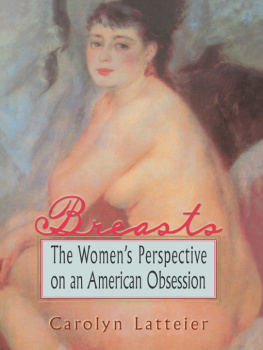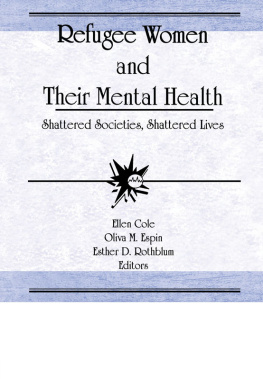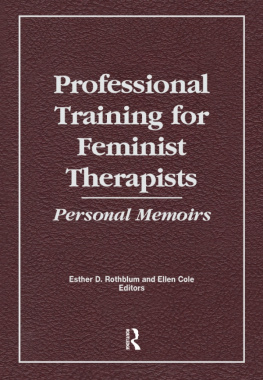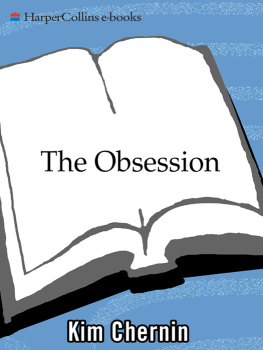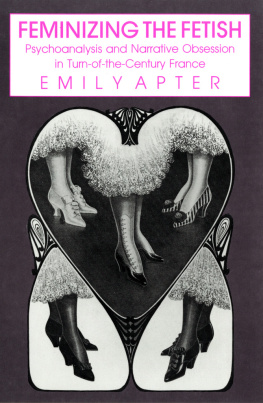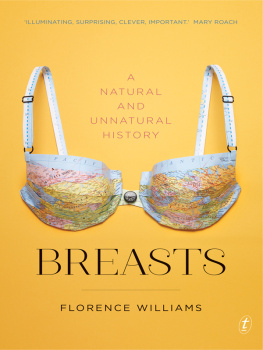Breasts
The Womens Perspective
on an American Obsession
HA WORTH Innovations in Feminist Studies
Esther Rothblurn, PhD and Ellen Cole, PhD
Senior CO-Editors
New, Recent, and Forthcoming Titles:
Prisoners of Ritual: An Odyssey into Female Genital Cizumcision in Africa
by Hanny Lightfoot-Klein
Foundations for a Feminist Restructuring of the Academic Disciplines
edited by Michele Paludi and Gertrude A. Steuernagel
Hippocrates ' Handmaidens: Women Married to Physicians by Esther Nitzberg
Waiting: A Diary of Loss and Hope in Pregnancy by Ellen Judith Reich
God k Country: A Case Against Theocracy by Sandy Rapp
Women and Aging: Celebrating Ourselves by Ruth Raymond Thone
Women 's Conflicts About Eating and Sexuality: The Relationship Between Food and Sex
by Rosalyn M. Meadow and Lillie Weiss
A Woman 's Odyssey into Africa: Tracks Across a Life by Hanny Lightfoot-Klein
Anorexia Nervosa and Recovery: A Hunger for Meaning by Karen Way
Women Murdered by the Men They Loved by Constance A. Bean
Reproductive Hazards in the Workplace: Mending Jobs, Managing Pregnancies
by Regina Kenen
Our Choices: Women's Personal Decisions About Abortion by Sumi Hoshiko
Tending Inner Gardens: The Healing Art of Feminist Psychotherapy
by Lesley Irene Shore
The Way of the Woman Writer by Janet Lynn Roseman
Racism in the Lives of Women: Testimony, Theory, and Guides to Anti-Racist Practice
by Jeanne Adleman and Gloria Enguidanos
Advocating for Self Women 's Decisions Concerning Contraception by Peggy Matteson
Feminist Visions of Gender Similarities and D~fferences by Meredith M. Kimball
Experiencing Abortion: A Weaving of Women 's Words by Eve Kushner
Menopause, Me and You: The Sound of Women Pausing by Ann M. Voda
Fat-A Fate Worse Than Death?: Women, Weight, and Appearance by Ruth Raymond Thone
Feminist Theories and Feminist Psychotherapies: Origins, Themes, and Variations
by Carolyn Zerbe Enns
Celebrating the Lives ofJewish Women: Patterns in a Feminist Sampler edited by Rachel
Josefowitz Siegel and Ellen Cole
Women and AIDS: Negotiating Safer Practices, Care, and Representation edited by Nancy
L. Roth and Linda K. Fuller
A Menopausal Memoir: Letters fmm Another Climate by Anne Hemnann
Women in the Antarctic edited by Esther D. Rothblum, Jacqueline S. Weinstock,
and Jessica F. Morris
Breasts: The Women S Perspective on an American Obsession by Carolyn Latteier
Lesbian Step Families: An Ethnography of Love by Janet M. Wright
Women, Families, and Feminist Politics: A Global Exploration by Kate Conway-Turner
and Suzanne Chenin
Women S Work: A Survey of Scholarship By and About Women by Donna Musialowski Ashcraft
Breasts
The Womens Perspective
on an American Obsession
Carolyn Latteier
First Published by
Harrington Park Press, an imprint of The Haworth Press, Inc., 10 Alice Street, Binghamton, NY 13904-1580
Transferred to Digital Printing 2010 by Routledge
270 Madison Ave, New York NY 10016
2 Park Square, Milton Park, Abingdon, Oxon, OX14 4RN
1998 by The Haworth Press, Inc. All rights reserved. No part of this work may be reproduced or utilized in any form or by any means, electronic or mechanical, including photocopying, microfilm, and recording, or by any information storage and retrieval system, without permission in writing from the publisher. Reprint - 2007
Cover design by Marylouise E. Doyle.
Library of Congress Cataloging in Publication Data
Latteier, Carolyn.
Breasts : the womens perspective on an American obsession / Carolyn Latteier,
p. cm.
Includes bibliographical references and index.
ISBN 0-7890-0422-4 (alk. paper).
1. BreastSocial aspects. 2. Body image in women. 3. WomenPsychology. 4. Self-esteem
in women. I. Title.
GT498.B47L37 1998
391.6dc2198-9556
CIP
ISBN 1-56023-927-1 (pbk.)
Publisher's Note
The publisher has gone to great lengths to ensure the quality of this reprint but points out that some imperfections in the original may be apparent.
CONTENTS
| Chapter 1. |
| Chapter 2. |
| Chapter 3. |
| Chapter 4. |
| Chapter 5. |
| Chapter 6. |
| Chapter 7. |
| Chapter 8. |
| Chapter 9. |
| Chapter 10. |
| Chapter 11. |
ABOUT THE AUTHOR
Carolyn Latteier, MA , is a freelance journalist and recent graduate of Washington State University, where she obtained her degree in American Studies. Specializing in writing articles on health and psychology, her work has been published in such newspapers as the Los Angeles Times , the Portland Oregonian, and the magazine Seattle. For her work, Latteier has won five awards from the Western Washington Society of Professional Journalists for excellence in journalism. Latteier has shown her slide presentation, The Social Construction of Breasts, to a number of audiences including the 1996 Lewis and Clark College Gender Studies Conference.
Preface
One night several years ago I had this dream:
I have discovered that women have long feelers growing out of their nipples. They use the feelers to test food. I am really happy about this extra function of breasts. I decide I will have to grow my feelers out. I had previously clipped them for cosmetic reasons.
It strikes me that this dream, with its strange and beautiful images of tentacled bosoms, is not just about breasts. It hints at peoples capacity to test and verify the quality of things, to find out what might be nurturing or poisonous in the world around them. It presents an image of women in action, using their abilities to know and understand rather than keeping them clipped for cosmetic reasons. And it signals me that it is time to stop pruning back my own rhizomes and horizons.
In taking on this research about breasts and writing this book, I have let my feelers grow out, and it has, indeed, not always seemed very cosmetic. Last year, I presented a slide show called The Social Construction of Breasts to my colleagues in the American Studies Department at Washington State University. A number of my friends had graciously agreed to let me photograph their breasts, and for my presentation, I had added these to images from art, advertising, and soft-core pornography. The night before the show, I broke into a cold sweat. I was, I realized, going to be projecting large-screen images of dirty pictures in front of my entire department. That night I did not sleep well.
Despite my anxieties, my presentation was warmly received. But this feeling of working on a slightly off-color subject has continued to dog me. When I tell people what I am writing about, I have grown accustomed to seeing a peculiar ripple cross their faces. Sometimes peoples eyes dart quickly to my chest and then away.
These ricocheting eye movements make me nervous. Nonetheless, there are reasons to take a good look at the things we usually turn away fromthings that exist in the realm of what is not very nice. The truth is, the not very nice is hopelessly interwoven with the nice, and together the two form a fuller picture of who and what we are. People giggle, get embarrassed, and/or become overwhelmed by cleavage because breasts are the object of a cultural obsession. Examining our obsessions can be both enlightening and therapeutic. Here, it is not a question of gender. Both men and women are involved in fascinations and anxieties about breasts. Both sexes need to test the food our culture offers; both need to let their feelers grow.

